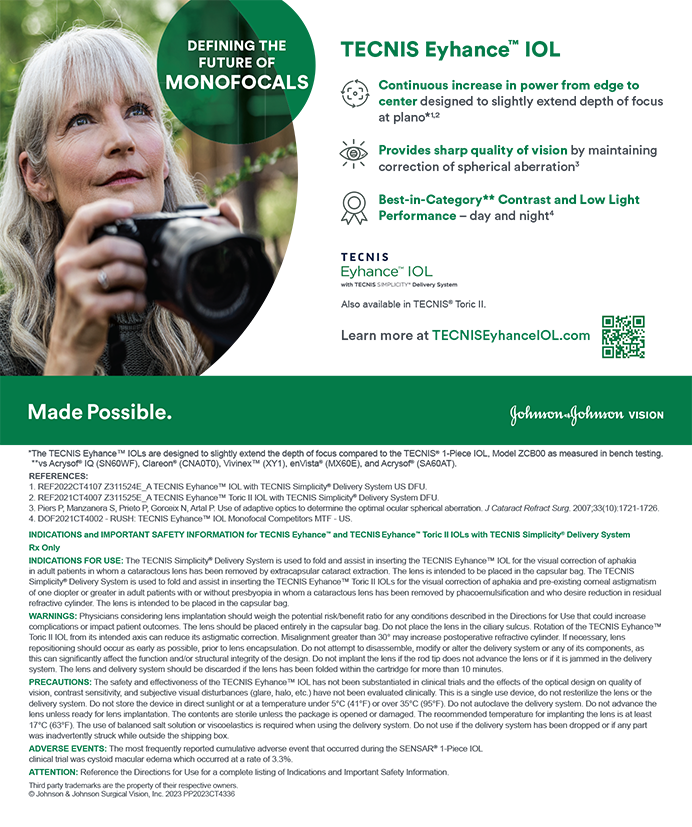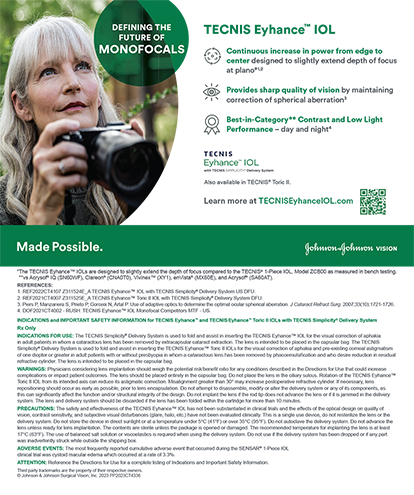Anterior segment surgery has evolved from large-incision intracapsular cataract extraction to bimanual microincisional phacoemulsification. Complications related to the inadvertent intraoperative injury of the capsule or zonules, the bag/sulcus placement of an IOL, postoperative trauma, capsular contraction syndrome, or progressive zonulopathy from pseudoexfoliation syndrome may require the surgical repositioning of the optic. An IOL exchange may become necessary if the lens is sufficiently unstable or dislocated, if the IOL is improperly sized or centered, if lenticular opacification or dysphotopsias occur, or if the IOL causes an ocular comorbidity (eg, corneal edema, anterior chamber inflammation, uveitis-glaucoma-hyphema syndrome, or cystoid macular edema). When manipulating an IOL in such situations, exquisite control of the anterior segment, and at times the posterior segment, is of great utility to the surgeon. Microinstrumentation and small incisions can enhance the stability of the anterior chamber, vitreous management, and the security of the IOL.
MicroSurgical Technology (MST; Redmond, WA) manufactures the microanterior segment set, which consists of a micrograsper, a microtying forceps, microscissors (straight and angled), and an optional IOL cutting scissors (Figure 1). Two different types of handle are available, and the differing functional heads can be interchanged. One of the handles only permits the interchanging of the different heads, whereas the other allows an additional 360° rotation of the instrument's head. In order to close the forceps' or scissors' tip, the surgeon squeezes his thumb and index finger in a pincer grasp around the handle while the shaft of the handle rests on his middle finger.1 This article reviews the microinstruments from MST and their use.
MICROGRASPER
The micrograsper has a 23-gauge tip, allowing this instrument to access the anterior chamber through a sub-1-mm incision. The forceps' angled, semisharp tip enables the instrument to engage and grasp tissue (eg, iris, capsule) or an IOL easily. The inner surface of the jaws is smooth to avoid traumatizing ocular tissue during maneuvers in the anterior chamber. We prefer the straight design, which allows for easy 360° rotation of the tip.
During IOL exchange, the main use of the micrograsper is for securing the IOL. It is not uncommon for a subluxated IOL in the posterior chamber to be floating freely on the anterior hyaloid face, from where it is dangerously close to falling posteriorly toward the retina. We use the micrograsper to secure the IOL by its haptic, its optic, or the anterior capsule, provided that the adhesion between the IOL and the capsular remnant is sufficient to ensure that grasping the capsule means securing the IOL. After the IOL has been captured and freed of vitreous adhesions, the surgeon may use the micrograsper to bring the IOL forward into the anterior chamber with the assistance of instruments such as a Kuglen or Sinskey hook. The pupil may then be constricted with intracameral acetylcholine and the microforceps, and the IOL may be explanted (Figure 2).
When a PCIOL must be explanted from the capsular bag—with or without an intact posterior capsule—we find the micrograspers useful for lifting the anterior capsule off the optic or the posterior capsule so that we may viscodissect the capsular bag to free the PCIOL (Figure 3). Once the optic and haptics are mobile, we use the micrograsper and a hook to dial the PCIOL out of the bag. If we cannot move a haptic, we use the micrograsper and IOL cutting scissors to amputate it.
We also find the micrograsper useful for handling iris tissue during the implantation of iris-claw–style IOLs. The forceps is an alternative to an enclavation needle. We fixate the IOL with a microtying forceps. We use the micrograsping forceps to engage the iris beneath the claw haptic and bring the iris tissue anteriorly through each side of the claw2 (Figure 4). We repeat the procedure with the other haptic to fixate the IOL completely.
If profound zonular weakness is destabilizing the IOL but the capsular bag is intact or in the setting of primary cataract extraction, we may use a capsular tension segment (requires an exemption for compassionate use from the FDA) to safely fixate an endocapsular IOL. The capsular tension segment's precise positioning is essential as we pass the needle through the fixation islet, and we have found the micrograsper useful for manipulating the device (Figure 5).
MICROTYING FORCEPS
The microtying forceps has a smooth, rounded, 23-gauge tip and a smooth inner surface to minimize trauma to the suturing material. The instrument is designed to fit through incisions of approximately 1 mm. Iris fixation of IOLs as well as pupillary repair and iris suturing require the ab interno tying of sutures. Although the McCannel suturing technique and the Siepser sliding knot and its variations are the most commonly utilized methods of tying sutures passed through the iris, these techniques require that iris tissue be brought to a corneal incision for tying a secure knot. Tears in the iris, iridodialysis, and/or hyphema may occur, resulting in a haptic's slipping off the suture knot fixating it to the iris. Using two microtying forceps to tie a suture knot in the anterior chamber minimizes manipulation of and trauma to the iris. The use of microincisions helps to maintain anterior chamber stability (Figure 6). We then use a microscissors to cut the ends of the suture (typically 10–0 polypropylene) after tying the knot and positioning the IOL (Figure 7A).
MICROSCISSORS
MST manufactures two types of microscissors: straight, available in 21- and 23-gauge sizes, and angled vertical, available in 21 gauge. In addition to their aforementioned utility when cutting suture knots, we use these scissors to sever thin strands or small sheets of vitreous present in the anterior chamber and attached to corneal incisions. Surgeons may also use microscissors to create small sphincterotomies in the iris at the pupillary margin to enlarge a small pupil, to create relaxing incisions in iris tissue to facilitate pupilloplasty, and to incise the anterior or posterior capsule to facilitate the enlargement or creation of a capsulorhexis (Figure 7B).
IOL CUTTERS
The 19-gauge IOL cutters are slightly heavier duty than MST's microscissors. The IOL cutter fits through a standard 2.5-mm clear corneal coaxial phaco incision. In cases of a malpositioned acrylic or silicone IOL, the surgeon may use the IOL cutter to segment the lens to allow for its removal through an incision smaller than the optic3 (Figure 8). This instrument may also be used to amputate a haptic from the optic if required.
CONCLUSION
Although the endocapsular implantation of an IOL is usually successful, complications may arise that necessitate an IOL exchange. Microinstrumentation enables anterior segment surgeons to use small incisions and work in a closed system, and it provides exquisite control of anterior chamber stability as well as greater ease of vitreous management. When iris repair or iris-sutured fixation of an IOL becomes necessary, we find that microinstrumentation enables us to handle delicate ocular tissues without further injury or trauma.
Iqbal Ike K. Ahmed, MD, FRCSC, is Assistant Professor at the University of Toronto and Clinical Assistant Professor at the University of Utah in Salt Lake City. He acknowledged no financial interest in the products or company mentioned herein. Dr. Ahmed may be reached at (905) 820-3937; ike.ahmed@utoronto.ca.
Jennifer Calafati, MD, is a Research Fellow at the University of Toronto. She acknowledged no financial interest in the products or company mentioned herein. Dr. Calafati may be reached at (905) 820-3937; jennifer.calafati@hotmail.com.
Diamond Y. Tam, MD, is a Clinical and Research Fellow at the University of Toronto. He acknowledged no financial interest in the products or company mentioned herein. Dr. Tam may be reached at (905) 820-3937; diamondtam@gmail.com.


